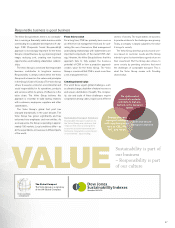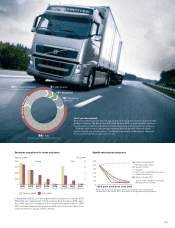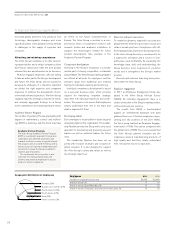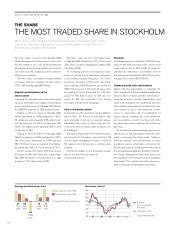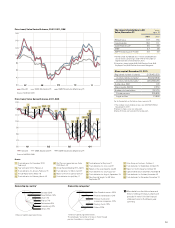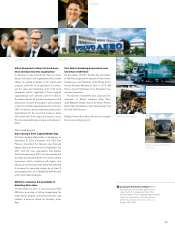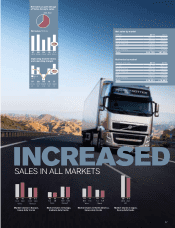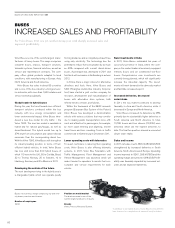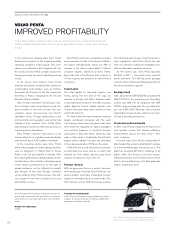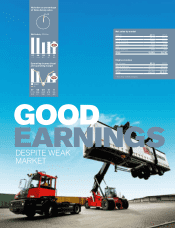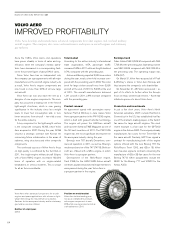Volvo 2011 Annual Report Download - page 60
Download and view the complete annual report
Please find page 60 of the 2011 Volvo annual report below. You can navigate through the pages in the report by either clicking on the pages listed below, or by using the keyword search tool below to find specific information within the annual report.
The truck operations consist of Volvo Trucks, Renault
Trucks, UD Trucks, Mack Trucks and VECV in India
(50% direct and indirect ownership). The product
offer stretches from heavy-duty trucks for long-
haulage and construction work to light-duty trucks
for distribution.
Number of employees
41,469
Demand in Europe and North America increased
during the year, but towards the end of the year it
weakened in Europe. The Japanese market was
negatively affected by the earthquake and tsunami
that hit the country in March but recovered
towards the end of the year. In Brazil demand
was strong during the year.
Total market
In 2011 the heavy-duty truck market in Europe
29 (EU, Norway and Switzerland) increased by
35% to 242,400 trucks compared to 2010. The
situation still varied significantly within Europe.
While parts of Southern Europe were struggling,
other regions in Northern and Eastern Europe
had recovered from the low levels of 2010. In
2012, the total market for heavy-duty trucks in
Europe 29 is expected to experience a moder-
ate decline to a level of about 220,000 trucks.
The start of the year is expected to be slow with
a gradual pick-up in demand as customers start
to renew their fleets ahead of the new emission
regulation in 2014.
In 2011, the total market for heavy-duty trucks
in North America increased by 52% to 216,100
trucks compared to 142,100 in the previous
year. Demand was strong throughout the year,
driven primarily by the need to replace the
industry’s aging highway tractor population.
Activity in the refuse vehicle segment was
steady. Although the vocational truck segment
continued to suffer as a result of the depressed
construction market, some positive signs were
seen in the energy sector, particularly natural
gas production. In 2012, the total market for
heavy-duty trucks in North America is expected
to grow to a level of about 250,000 trucks.
In 2011, the total market in Brazil increased
by 2% to 111,500 heavy-duty trucks (109,800).
The increase was lower than anticipated
because of less prebuying than expected ahead
of the new, stricter emission regulation that
came into effect on January 1, 2012. The total
Brazilian market for heavy-duty trucks is
expected to record a slight decline and reach a
level of about 105,000 trucks in 2012. The
beginning of the year is expected to be slow fol-
lowed by a gradual pick-up in demand driven by
a general increase in economic activity and
increased acceptance of the new, more expen-
sive Euro V trucks.
In Japan the market for heavy-duty trucks
was 24,800 vehicles in 2011 (24,500), which
was an increase of 1%. Following the earth-
quake and the subsequent tsunami that hit
Japan on March 11, 2011 there were signs of a
market-recovery during the latter part of 2011
and into 2012. For 2012, the total Japanese
market for heavy-duty trucks is expected to
increase to about 30,000 trucks.
The Indian market for heavy-duty trucks grew
by 12% to 237,000 trucks in 2011 compared to
212,000 vehicles in 2010.
Earnings
In 2011, net sales in the truck operations increased
by 24% to SEK 207,703 M (167,305). The operat-
ing income improved to SEK 18,260 M (10,112),
while the operating margin was 9.1% (6.0).
Increased sales volumes, higher capacity utili-
zation and continued strict control on operating
costs had a positive impact on profitability.
TRUCKS
CONTINUED EARNINGS IMPROVEMENT
2011 was characterized by a continued recovery in demand in the Group’s mature
markets and a continued strong development in the emerging markets. Towards the
end of the year the first signs of a moderate slowdown became visible in Europe.
Position on world market
In total, the Volvo Group is Europe’s largest and the
world’s second largest Western manufacturer of
heavy trucks.
Brands
Volvo, Renault Trucks, UD Trucks, Mack and Eicher.
New products
At the annual Mid-America Trucking Show in Lou-
isville, Kentucky, both Mack and Volvo Trucks
introduced trucks with new aerodynamic and
powertrain features which, when combined with
the improvements already achieved through the
use of SCR technology, deliver fuel efficiency
gains of 8-12% over previous generations of
trucks (EPA 2007).
The world’s most powerful hybrid truck was
launched by Volvo Trucks in the first quarter. The
Volvo FE Hybrid, the first parallel hybrid from
Volvo Trucks, uses techniques able to reduce fuel
consumption and carbon dioxide emissions by up
to 20%, and it makes the truck much more silent.
In May, Volvo Trucks launched the new Volvo
FM MethaneDiesel truck, a gas-powered truck for
long-haul operations enhancing its focus on alter-
native fuels. This truck can be powered by up to
75% gas and if run on biogas, emissions of car-
bon dioxide from fossil fuel could be cut by up to
70% compared with a conventional diesel engine.
In September, a 750 hp version of the Volvo
FH16 was launched.
Renault Trucks delivered the first serial Renault
Premium Distribution hybrid truck (Hybrys Tech).
Renault Trucks also launched a system called
Optiroll on the Renault Premium Route Optifuel
truck, which further reduces fuel consumption.
In July, UD Trucks launched its new Condor
medium-duty trucks, which have undergone a
full model change.
BOARD OF DIRECTORS’ REPORT 2011
Fuel-efficient engines is one important factor
behind the truck operations’ success.
56



